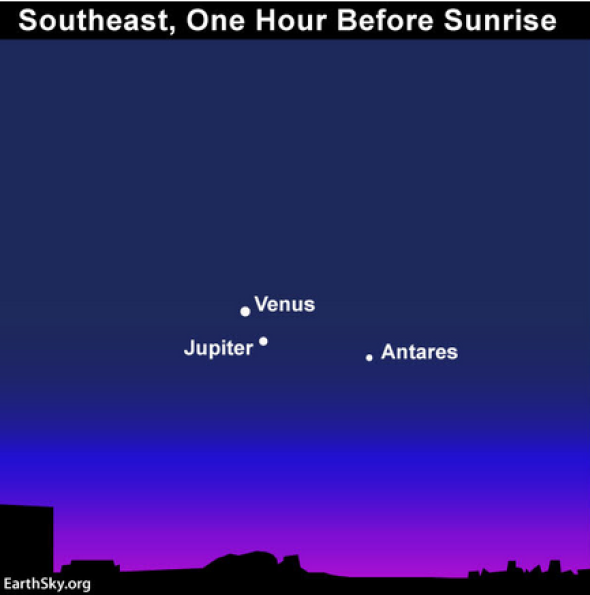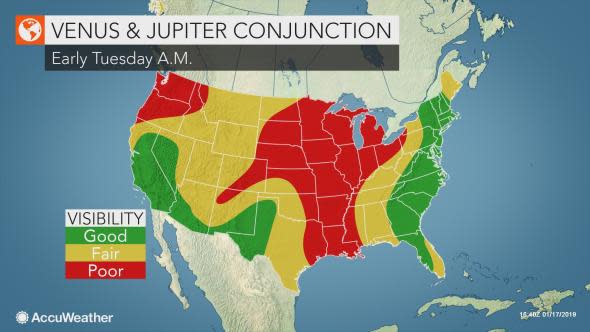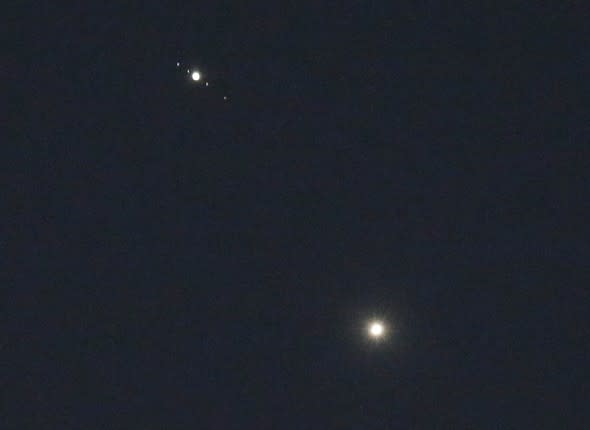Venus-Jupiter conjunction: Set your alarm for this celestial meet-up on Tuesday morning
Jupiter and Venus will shine bright together before dawn on Tuesday in an astronomical event known as a conjunction.
"A conjunction is a celestial event in which two planets or a planet and the moon or a planet and a star appear close together in the night sky," according to the NASA website.
Close encounters of Jupiter and Venus in the sky occur on a fairly regular basis, most recently happening on Nov. 13, 2017.

Jupiter and Venus will appear in the southeastern sky before dawn on Tuesday. (Image/EarthSky)
It will be hard to miss the two planets in the southeastern sky early Tuesday morning with Venus being the brighter of the two.
"The Jupiter and Venus conjunction will be easily bright enough to see from any location, even large cities," NASA reported.
The pair of planets will be rising together, climbing above the horizon by 5 a.m. local time.
Although they will appear right next to each other in the sky, the two planets will actually be over 400 million miles apart.
Following cloudy weather for Sunday night's eclipse, stargazers in the northeastern United States will have much better viewing conditions for Tuesday morning's planetary meet-up.
"Skies will be mostly clear across much of the country east of the Mississippi, but the coldest temperatures so far this winter season are expected," AccuWeather Astronomy Blogger Dave Samuhel said.
Samuhel also expects mainly clear weather over California, leading to good viewing conditions.
"A storm over the Rockies will bring plenty of clouds from the Four Corners to the northern Plains," Samuhel said. "Some clouds could also affect the Northwest depending on the track of the next storm."
If it is too cloudy on Tuesday morning to see the conjunction, folks can look for the planets in the same part of the sky before dawn in the days following, as Jupiter and Venus will still appear close to each other.

No special equipment is needed to spot the two planets in the pre-dawn sky as they are each bright enough to see with the naked eye, even in cities with high light pollution. However, a telescope or pair of binoculars will reveal some extra details, such as the four largest moons of Jupiter.
These moons, known as the Galilean moons, will look like small stars surrounding Jupiter.
Some telescopes may also allow onlookers to see bands of clouds in the planet's atmosphere, and perhaps even the famous Great Red Spot.

The planets Venus, bottom, and Jupiter, top center, light the sky above Matthews, N.C., Monday, June 29, 2015. (AP Photo/Chuck Burton)
Jupiter and Venus will slowly drift farther apart in the night sky, but before dawn on Jan. 31, early risers will be treated with another close encounter.
The crescent moon will appear incredibly close to Venus in the southeastern sky. Venus and the moon will appear so close to each other that they will easily fit in the same field of view for those peering through the lens of a telescope or binoculars.
The following morning, the thinly crescent moon will fall in line with Jupiter, Venus and Saturn in the same area of the sky.
Those that miss next week's conjunction will only have to wait until Nov. 23, 2019, to see Venus and Jupiter meet up again in the night sky.
Questions or comments? Email Brian Lada at Brian.Lada@accuweather.com and be sure to follow him on Twitter!
Follow @wxlada

